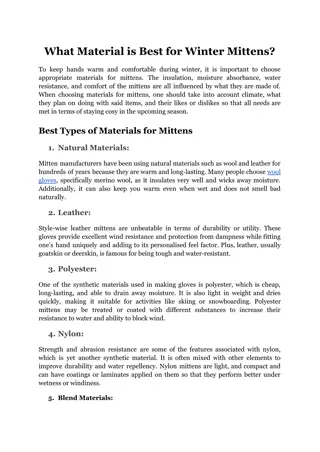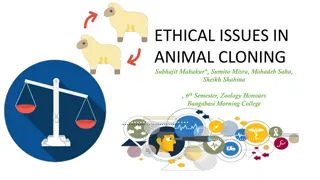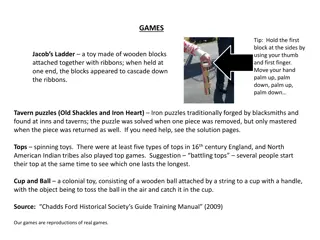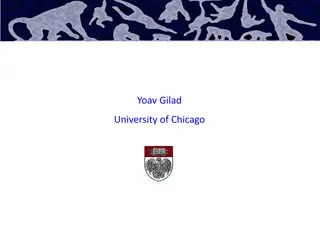Understanding Primate Characteristics: Movement, Dexterity, and More
Primate characteristics encompass a range of physical traits tailored for their environments, like adept movement abilities and dexterity in their hands and feet for grasping objects. Their unique skeletal structure allows for flexibility and skilled locomotion. Learn about the fascinating features that set primates apart from other animals.
Download Presentation

Please find below an Image/Link to download the presentation.
The content on the website is provided AS IS for your information and personal use only. It may not be sold, licensed, or shared on other websites without obtaining consent from the author. Download presentation by click this link. If you encounter any issues during the download, it is possible that the publisher has removed the file from their server.
E N D
Presentation Transcript
The Primates Primate Characteristics Movement and Locomotion Dentition, Eyesight, and Brain Size Reproduction and Maturation 9/15/2024 1
The Primates Humans are members of the mammalian order Primates, a diverse group of animals that also includes monkeys, prosimians, and apes. While a diverse group, primates share a number of key characteristics, such as large brain size, keen vision, dexterous hands, and a generalized skeleton that allows for great physical agility. Primates also tend to have smaller litters than other animals, devoting more care and attention to the rearing of their offspring. However, the unique combination of traits found in the primates distinguishes them from other animals. 9/15/2024 2
Primate Characteristics Primate characteristics incorporate a wide variety of physical and anatomical traits that represent adaptations environments, particularly adaptations that is, life in the trees. They include features related to locomotion and movement, diet, vision, and maturation. many of these features were likely important in the adaptive abilities of early human ancestors. to a variety arboreal of 9/15/2024 3
Movement and locomotion Among the most important physical characteristics of primates is their generalized skeletal structure that allows for a great deal of flexibility in movement. Consider, for example, the clavicle, or collarbone, a feature found in early mammals. In primates, the clavicle provides both support and flexibility, enabling them to rotate their shoulders and arms to perform a range of movements. In the wild, this skeletal structure gives primates the ability to reach for branches and food while roaming through treetops, or to manipulate objects. Humans, of course, do not live in trees. However, their generalized primate skeleton is what allows them to drive cars, catch baseballs, and throw spears. There is also a tendency toward upright posture in all primates. Though most pronounced in humans, all primates can stand; upright walking is occasionally found in nonhuman species such as the chimpanzee and orangutan. 9/15/2024 4
Dexterity Dexterity in the digits (fingers and toes) of the feet and hands, another key primate trait, makes it easy for primates to grasp and manipulate objects. All primates (except for the callitrichids) have sensitive pads and nails on their fingertips rather than claws, and many have five digits on their hands and feet. Primate digits are prehensile or highly effective for grasping. Consequently, in contrast to cats or rodents with claws, primates climb by wrapping their hands and feet around branches. A particularly important aspect of the primate hand is the opposable thumb, found in humans and many other primates. Humans can touch the tips of each of their fingers with the thumb, an ability that makes them adept at manipulating small objects. Some primates do not have opposable thumbs, but all members of the Primate order share a high degree of digit mobility. 9/15/2024 5
Dentition, Eyesight, and Brain Size Dentition or the number, form, and arrangement of teeth, serves as a distinguishing characteristic of many types of animals. Because they are strong and are often better preserved in the fossil record than other parts of the skeleton, teeth are particularly valuable evidence for paleontologists who use them to identify extinct primates. Compared to other mammals, primates have multipurpose teeth that can be used for either cutting or crushing foods. The dental structure of primates is generally consistent with an omnivorous diet made up of a variety of foods, from plants, fruits, nuts, and seeds to insects and other animals. Different teeth perform different functions. Their shape varies from one primate species to another as a result of evolutionary adaptations to particular food-processing situations. The anterior (front) teeth, including the incisors and canines, are used to transfer food into the mouth. They are designed for cutting, tearing, and biting. 9/15/2024 6
Continued The posterior (back) teeth, including the molars and premolars, are more specialized for breaking down food by crushing or grinding. However, depending on their adaptations, the number and form of the various teeth is different in different species. For example, the canine teeth of a carnivore, such as a lion, are pronounced and the premolars pointed; they are better suited for biting and tearing meat. In contrast, the molars of plant-eating animals, like cows and horses, are broad and flat for masticating fibrous plant material. Unlike lions or horses, primate teeth are not overly specialized with regard to size and shape. Human teeth, for example, exhibit some differences our canines are clearly different in shape from our molars but they are all relatively the same size. This makes them multipurpose teeth suitable for eating just about everything. Primates unspecialized dentition indicates an evolutionary trend throughout their history toward an omnivorous diet. 9/15/2024 7
Vision Refined vision also sets primates apart. Whereas many animals are highly dependent on olfaction, the sense of smell, primates, having large eyes oriented to the front and protected by bony structures, rely heavily on vision. This visual orientation favors binocular and stereoscopic vision in which the visual fields of the eyes overlap, transmitting images to both sides of the brain. Primates benefit from enhanced depth perception as a result. Evolution has also made the retina of primates eyes sensitive to different wavelengths of light, producing color vision in most primates. Primates depend upon their highly developed visual sense to identify food and coordinate grasping and leaping. 9/15/2024 8
continued This visual acuity has important adaptive implications. On one hand, it would have facilitated life in an arboreal environment, making it easy for primates to move through the trees. On the other hand, acute vision would have also enhanced primates food-getting ability, including the gathering of seeds and berries. It could have also facilitated hunting . Eyes oriented to the front are a characteristic generally found in predators, and this trait would have allowed primates to effectively hunt for insects, amphibians, or other creatures. 9/15/2024 9
Complexity of the Brain Distinguishing primates even more than the preceding characteristics are the size and complexity of the brain. This is a trend among the placental mammals in general, but particularly notable among the primates. Relative to body size, primates have larger brains than any other land animal; only the brains of some marine mammals are of comparable relative size. In primates, the neocortex, the surface portion of the brain associated With sensory messages and voluntary control of movement, features a large number of convolutions, or folds, that maximize the surface area. This implies development of the brain functions associated with the processing and integration of both motor and sensory functions. As they evolved, these larger, complex brains undoubtedly helped primates to locate and extract food and to avoid predators. 9/15/2024 10
Reproduction and Maturation In contrast to most other animals, primates reproduce few offspring, and these undergo long periods of growth and development. The gestation period for primates that is, the length of time the young spend in the mother s womb is longer than that of non primate animals of comparable size. Primate offspring are born helpless and unable to survive on their own. For this reason, they have long periods of maturation, during which they remain highly dependent on their parents and other adults. As an example, a kitten reaches full adulthood at one year, whereas a baboon takes seven or eight years to reach maturity. Humans, in contrast, have a period of infancy that lasts six years. Full adulthood, characterized by the appearance of the third molars, or wisdomteeth, is reached at 20 years of age. This protracted maturation process has adaptive advantages. Parents invest much more time in the care and rearing of their offspring, ensuring greater survival rates. Living in social groups, immature primates learn complex tasks, primarily by observing their mothers and fathers, but also by observing others in their social group. Through this social learning, primates gain the skills needed to locate food and shelter and to elude predators. 9/15/2024 11























